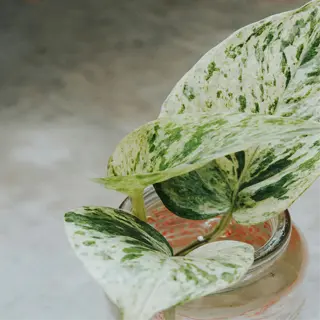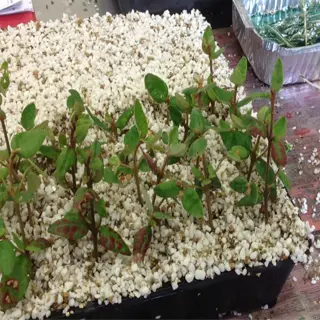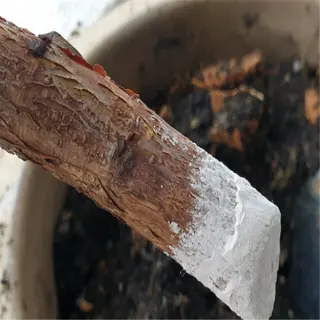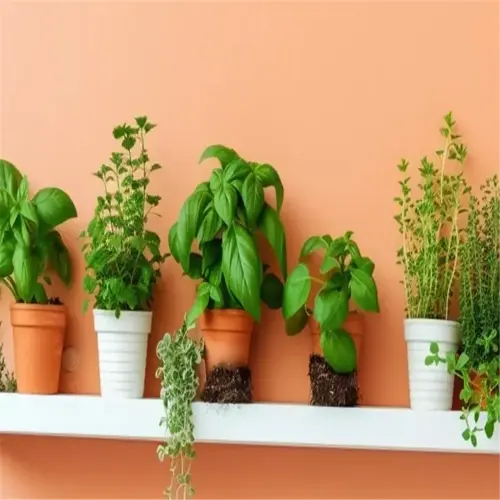The Complete Guide to Grow From Cuttings Successfully

Written by
Tina Carter
Reviewed by
Prof. Charles Hartman, Ph.D.Grow your cuttings using water or soil for reliable success
Using a sharp tool and a rooting hormone accelerates cutting propagation
Cuttings work well for propagating herbs, houseplants, and woody plants
Avoid exposing plants to extreme sunlight; humidity is the key to great roots
Transplant cuttings when roots reach 3-5 inches for stability
About overgrown propagated plants, spread your success to other gardeners to promote a sustainable gardening community.
Article Navigation
By learning how to propagate from cuttings, you will have access to limitless experiences in the garden. You can expand your gardening collection without needing to buy new plants. Imagine taking a rosemary stem from your kitchen, putting it in water, and watching it become a bush. Propagation allows you to clone a favorite plant without buying another. Cloning lends itself to a feeling of sustainability - it becomes a natural part of your green routine.
To start, use herbs like basil or mint. These plants will be forgiving when you make rookie errors. I even revived a dying rosemary plant once using one 4-inch cutting. Always use sterilized shears to make a clean cut. If you want quick results dip the stems in rooting hormone. You can root using water or potting soil. Your choice is dependent on the type of plant.
Pothos and spider plants are popular among houseplant lovers, as they will root quickly. My first propagation success was with a spider plant pup gifted by a friend. Simply place your cuttings in bright indirect light, and avoid putting them in soggy soil. You should change the water weekly to prevent bacterial growth. Readability is improved with patience while the roots grow.
Water vs. Soil Propagation Methods
Deciding whether to use water or soil propagation will affect your success as a plant grower. Herbs such as mint will propagate faster in water. You also can see the roots growing through glass jars. Woody plants, like rosemary, require soil. The stems are thicker and tend to rot in water. Beginners often choose water propagation because it provides immediate gratification.
Propagation in water will show you the growth of roots, but can also lead to a very slimy experience. It is important to change water every three days or so. I lost a lavender cutting once by not doing so. Propagation in soil will hide roots, but provide stability. Use a rooting hormone in stubborn plants. Mix soil with perlite to avoid any mold.
Controlling humidity in the soil is most important. I recommend covering pots with plastic bags. The humidity is contained in the bag, and it may even create moisture like a tropical climate. I have a spider plant that thrived this way. Be careful to not over-water. Mold may more readily grow in wet soil. Let the top chunk of soil (about an inch) dry before rehydrating your plant. Also, adjust lighting based on the needs of your plant.

Water Propagation Jar
- Transparent containers allow root monitoring
- Mason jars prevent algae growth better than plastic
- Filtered water reduces mineral buildup on stems
- Avoid direct sunlight to prevent overheating

Soil Propagation Station
- Drainage holes prevent waterlogged roots
- Perlite improves aeration in dense soils
- Maintain 70°F (21°C) for tropical species
- Plastic wrap increases humidity effectively

Humidity Dome Setup
- Maintain 70% humidity for tender cuttings
- Ventilate daily to prevent fungal growth
- Use spray bottle for gentle misting
- Clear plastic allows light penetration

Rooting Hormone Application
- Dip stems for 3 seconds before planting
- Willow water works as natural alternative
- Store powder in cool, dry place
- Wear gloves to avoid skin irritation

Lighting Setup
- 12-16 hours daily for most plants
- LED lights produce less heat than HPS
- 40-watt bulbs suit small propagation areas
- Adjust height as plants grow
Essential Tools for Success
Sanitizing instruments distinguishes successful cuttings from hopeless experiments. Use rubbing alcohol to wipe the sharp knife or pruners after each cut. I've salvaged entire batches of basil, using medical-grade wipes in place of expensive garden products. For herbs, any regular scissors will suffice. If stems are woody, you need to use bypass pruners to avoid crushing fragile tissues.
A plastic bag becomes a humidity dome for propagating soil. You can reuse bread bags so you do not have to buy propagation supplies from the nursery. For succulents, I have rooted jade cuttings in takeout containers; I made drainage holes by poking the containers with a nail. Appropriate tools are tailored to your plant's needs, you can propagate tender herbs with very little and succeed with roses only using rooting hormone and are capable of preparing with tools if they are essential for your planting task.
Instead of commercial rooting hormones, honey or aloe vera gel can be used. My grandmother used raw honey for rooting fig cuttings for decades. My grandmother dipped the stems in honey before planting them to promote root growth. For heavy-duty rooting, powdered rooting hormones can be worth the cost. If you decide to mix up your rooting mixture, do not forget to label it so you don't forget what it is the next time you go to the kitchen.
Pruners/Sharp Knife
- Disinfect blades between plants with isopropyl alcohol
- Make 45° angle cuts below leaf nodes
- Replace blades when cutting efficiency drops
Rooting Hormones
- Dip cuttings for 3-5 seconds before planting
- Willow water alternative: soak willow stems for 48 hours
- Store powder in airtight container to prevent clumping
Plastic Covers
- Maintain 70-80°F (21-27°C) under dome
- Ventilate daily to prevent mold growth
- Use chopsticks to prop up plastic away from leaves
Seedling Heat Mats
- Set to 75°F (24°C) for tropical plant cuttings
- Place under propagation trays for consistent warmth
- Avoid direct contact with plastic covers
Spray Bottles
- Mist cuttings 2x daily in low-humidity environments
- Use distilled water to prevent mineral deposits
- Adjust nozzle for fine mist distribution
Best Plants to Grow From Cuttings
Embark on your journey of growing from cuttings with easygoing herbs such as mint and basil that grow roots in water within just a few days. I currently have a mint jungle on my kitchen windowsill grown from cuttings off of herbs I bought at the grocery. Other edible herbs including oregano and thyme also do well when doing this method. Fast results build confidence!
Houseplants are certainly a genre to find the ease of propagation. I can root pothos cuttings faster than most backyard weeds sprout. I've given away dozens of cuttings that have simply cloned from the mother plant I've had for ten years. Spider plants give you ready-made little pups- just snip them off when they get their little aerial roots. Both of these plants take low light and a lack of regular care.
Woody plants can take time to produce results, but with some patience, they can yield worthwhile outcomes. Rosemary and hydrangeas root the best in soil when rooting hormone is used, and my first successful hydrangea cutting took eight weeks before blooming, but now it blooms every year. Make sure you use semi-hardwood stems, as stems that are too green and/or completely woody do not root well.
Steer clear of typical errors by utilizing plants that are appropriate for your climate. For example, tomato transplants will root quicker than peppers. Figs can be propagated as cuttings in a warm climate, where my neighbor turned a 6-inch stick into a fig tree. Remember to pay attention to moisture because rot kills more cuttings than drought ever will.
Herbs
- Take 4-6 inch cuttings from new growth
- Root in water for visible progress
- Transplant when roots reach 2 inches
Succulents
- Let cuttings callous for 24 hours before planting
- Use sandy soil mix for drainage
- Avoid watering for first 7 days
Houseplants
- Include at least one node in cuttings
- Use plastic cover to maintain 70% humidity
- Rotate pots weekly for even light
Flowering Shrubs
- Take hardwood cuttings in late fall
- Dip in rooting hormone for woody stems
- Keep in shaded area until established
Trees
- Use air layering for best results
- Select branches thicker than a pencil
- Expect 6-12 month establishment period
Step-by-Step Water Propagation
Starting with water propagation, you'll want stems with at least one beautiful little node - the bump where the leaves grow. Submerge this area under a fraction of a glass jar filled with water not exceeding two-thirds of the vessel. If you have any filtered water, the minerals will build up significantly slower. Using tap water is acceptable but will cloud up the fast. Any water can be replaced every three days to eliminate stagnation of power for any variety.
Position your jars where they will be in bright indirect light, as direct sunshine causes the water to heat up too much and can lead to algae. My very first pothos cutting that I began in water was placed in a north-facing bathroom window. This plant generated roots after 12 days. If you are propagating a slow starter such as mint, consider adding just a drop of liquid rooting hormone to help it propagate.
Cloudy water indicates the presence of bacteria, so dump the jar out immediately. Scrub it with vinegar before refilling it with fresh water. I have saved cuttings that failed by soaking the stems in hydrogen peroxide for 10 minutes, and then trimming off the mushy section, above a node. Start fresh with water. In some cases, it may be a problem, but having patience can sometimes rescue borderline cases.
Container Selection
- Use transparent glass jars for light penetration
- Mason jars prevent algae better than plastic
- Narrow necks support stem positioning
Water Quality
- Filtered water reduces mineral deposits
- Add charcoal piece to inhibit bacteria
- pH 6.0-7.0 optimal for root growth
Environment
- 65-75°F (18-24°C) ambient temperature
- Indirect sunlight prevents overheating
- Avoid drafty windowsills
Root Monitoring
- Check roots weekly for white, fuzzy growth
- Trim brown roots immediately with sterilized scissors
- Slow growth indicates insufficient light or nutrients
Transplanting Guidelines
- Use well-draining soil mix with perlite
- Acclimate plants to soil over 3-5 days
- Water lightly for first 2 weeks
Step-by-Step Soil Propagation
Soil propagating requires specific potting mix combinations. While herbs prefer a potting mix of *60% soil and 40% perlite* for drainage, woody plants will need a heavier loam blend to contribute extra water retention. I failed with *hydrangea* cuttings until I added a bit of sand to provide stability to the propagating roots. *Always match the density of soil based on plant preference*.
Installing a humidity dome will increase your success rate for cuttings. Finding a means to trap moisture, using a container, or a plastic bag is ideal. I used a salad clamshell for cuttings last spring. Be sure to uncover the cuttings for at least an hour a day to avoid mold. I also wiped condensation from the interior of the dome every morning. Once new leaves appear, remove the dome or container.
Transplant shock is responsible for the death of more cuttings than pests are. To harden off the plants, expose them to fresh outside air for 30 minutes every day, and when you transplant the cuttings, water them with diluted liquid seaweed extract to lessen the effects of moving them. My basil cuttings recovered within days of being in my garden using this process. Don't fertilize for two weeks after moving plants to reduce stress.
Before planting trim, consider dipping it into rooting hormone. Gel formulas tend to cling to the plant better than powders. For succulent cuttings, skip the hormone and dry them out overnight. I use cinnamon to root jade plants (and it acts as a natural antifungal). Just adjust these techniques to the quirks of each species.
Soil Mix Formula
- Use sterilized potting soil to kill pathogens
- Add perlite for drainage in clay-heavy soils
- pH 5.5-6.5 suits most flowering plants
Container Prep
- Disinfect pots with 10% bleach solution
- Drainage holes prevent root suffocation
- 4-6" depth accommodates most cuttings
Humidity Control
- 80% humidity accelerates root growth
- Use hygrometer to monitor levels
- Mist dome interior 2x daily
Light Requirements
- 14h daily under LED grow lights
- 2000-3000 lux for herbaceous plants
- Rotate pots every 3 days
Root Development
- Gentle tug test after 4 weeks
- White roots = healthy growth
- Discard cuttings with blackened stems
5 Common Myths
Rooting hormones need to be applied consistently everyday in order to be effective
Rooting hormones function by single application during planting. When over applied, growth is inhibited, as the hormone can "burn" the plant by creating a chemical burn. Naturally occurring substitutes, such as willow water or aloe vera gel, offer sustained auxin release and have no risk of overdose.
Cuttings need bright light for rapid root growth
Bright light can dehydrate the cuttings and slow rooting potential. Indirect light (1000-2000 lux) helps the cutting achieve photosynthesis without a stress reaction. East facing windows or using shaded grow lights can provide ideal conditions at 65-75F (18-24C) for root cell division.
All plants can be propagated in plain tap water
Woody plants like rosemary and lavender develop root rot in water long-term. Soil propagation with 70% humidity works better for species requiring airflow around root zones. Sensitive plants need pH-balanced filtered water to prevent mineral toxicity.
Bigger cuttings will grow faster than small cuttings
Oversized cuttings (12"+) have a hard time maintaining moisture balance. 4-6" stems with 2-3 nodes has optimal levels for nutrient allocation. Smaller cuttings with smaller energy reserves will develop roots, instead of sustaining unnecessary foliage.
Mist cuttings several times each day to minimize drying
Too much misting can stimulate fungal growth and stem rot. Allows for controlled environments utilizing humidity domes +/- 80-85% RH that allows for less watering. Only water when the soil surface is dry to a depth of 0.5"/1.25cm - usually every 3 - 4 days at +/- 70°F (21C) in a controlled or greenhouse environment.
Conclusion
Propagation from cuttings broadens the scope of gardening as an activity that includes everyone without any areas of expertise. A beginner can begin this process by taking basil in water. An expert might take cuttings of a rose plant in soil. My neighbor propagated a geranium from her grandmother using a yogurt container. All success stories begin with just one cut. With each shared plant, we grow a sustainability cycle.
Sharing cuttings creates community gardens and mitigates waste through rootings. I exchanged spider plant cuttings for compost I made at home. Soil-based propagation keeps heirloom varieties alive and beautiful. Mint roots as cuttings in water travel well in jars. And every cloned plant avoids the plastic nursery pot. Sharing roots tie us to nature and our neighbors.
Regardless of whether you decide to focus on water clarity or soil stability, you will feel empowered by each technique. My very first avocado pit sprouted roots in a teacup. Subsequent attempts grew in perlite mixes. Use water clarity vs soil stability techniques as your own gardening journey evolves. All the while, the one truth is: life comes from pieces.
Accepting imperfections. My sad little sage cutting perked up after three weeks. Some species can root very quickly. Others require more patience. Keep the jars on the windowsill. Share the extras with coworkers. Each cutting contributes to a greener world. The next cutting that you grow could become a beloved houseplant for someone.
External Sources
Frequently Asked Questions
Can all plants be grown from cuttings?
No, not all plants root successfully from cuttings. Herbs like mint, houseplants like pothos, and shrubs like hydrangea work best. Woody plants like lavender require specific techniques, while patented hybrids may have legal restrictions.
Is it safe to plant cuttings directly in soil?
Yes, but soil must be sterile and well-draining. Use a mix of potting soil and perlite. Dipping cuttings in rooting hormone improves success. Cover with a plastic bag to maintain 70-80% humidity until roots form.
Are there legal restrictions on plant propagation?
Propagation is illegal only for patented plants, which are genetically unique cultivars. Common garden plants like roses or herbs are unrestricted. Always check plant tags or breeder websites for patent warnings before cloning.
Which plants root fastest in water?
Herbs like basil and mint root in 7-14 days. Pothos and spider plants develop roots in 2-3 weeks. Avoid water propagation for woody plants like rosemary, which prefer soil for long-term success.
How long does rooting typically take?
Rooting time varies: soft-stemmed plants take 2-6 weeks, while woody cuttings may need 2-6 months. Factors like temperature (ideal: 65-75°F / 18-24°C) and humidity levels significantly impact speed.
Why do some cuttings never develop roots?
Common failures include:
- Using diseased or old plant material
- Overwatering causing rot
- Insufficient node submersion in water
- Low humidity levels during soil propagation
What's the easiest plant for beginners to propagate?
Pothos and spider plants are ideal starters. They root readily in water within 2-3 weeks. Mint and basil cuttings also thrive with minimal care, requiring only indirect light and weekly water changes.
Do cuttings need special care after rooting?
Yes, transplanted cuttings require:
- Gradual acclimation to lower humidity over 7 days
- Well-draining soil with perlite or vermiculite
- Indirect light for 2 weeks
- First fertilizer application after 30 days
Can I propagate plants without rooting hormones?
Yes, natural alternatives like willow water or aloe vera gel work. However, commercial rooting hormones increase success rates by 40-60% for difficult species like roses or fruit trees.
What mistakes ruin propagation attempts?
Critical errors include:
- Using dull tools that crush stems
- Leaving flowers/buds on cuttings
- Placing in direct sunlight
- Over-misting causing fungal growth
- Transplanting before roots reach 3 inches

